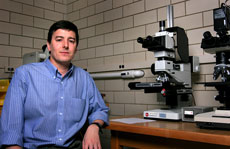Rogers recognized for science research

Online Poster
December 6, 2005
John Rogers, professor in Engineering, was selected by “Scientific American” to be included among the top 50 researchers in its “2005 Scientific American 50.” Rogers’ recognition highlights his developments in material sciences in an article titled “A Future in Plastics.”
“He’s recognized as a truly modern-day scientist who is broadly interested and has impacted many areas,” said Pierre Wiltzius, director of the Beckman Institute. “He is just a superb scientist and engineer; he is a true innovator.”
Rogers researches semi-conducting organic materials that work like silicon. Silicon, which is used for computers and other devices with Liquid Crystal Display screens, is fragile and brittle. Rogers is interested in alternative materials that avoid these problems, allowing ink-jet print screens to be thin without breaking.
The new materials allow low-temperature, paper-thin displays that can bend and roll. They can be used for flexible electronics.
“One company is able to make really sophisticated prototypes,” Rogers said. “Their first target application is a PDA (personal digital assistant) that rolls out of a pen.”
Get The Daily Illini in your inbox!
Rogers said the new materials would never work as fast or efficiently as silicon. Silicon is well understood and developed. But the research is a supplement to silicon, enabling new devices.
“Our goal is not to compete with things that silicon does well already,” Rogers said. “These unusual materials allow a range of applications – displays being the most obvious.”
The development in electronic materials is an interdisciplinary work, combining research in physics, chemistry and several branches of engineering.
“It really encompasses this kind of collaborative effort with expertise from a lot of different people,” Rogers said.
For the past four years, “Scientific American” has assembled a list of advancements in business, policymaking and research for its December issue.
“We do it to recognize major accomplishments each year in science and technology with an emphasis on applied technologies,” said Gary Stix, special project editor for “Scientific American.”
Editors and a group of outside advisers, which often included previous winners, nominate candidates for recognition. They then choose 50 from the list of 150 to 200 nominees.
“We evaluate what contributions they have made during the previous 12 months,” Stix said. “We also consider whether the research is worthy of recognition – either it has had or will have impact on technologies.”
Rogers said many people have made interesting advancements in the past year, which causes degrees of chance and randomness to a list of the top 50.
“It’s a nice recognition, but you take it with a grain of salt,” Rogers said. “It’s good to get the recognition for the students doing the research. It’s a good development.”
Rogers received his bachelor degree at the University of Texas in Austin, doctorate at Massachusetts Institute of Technology and post doctorate at Harvard. He spent five years at Bell Labs, a part of Lucent Technology, before coming to the University in January 2003.






